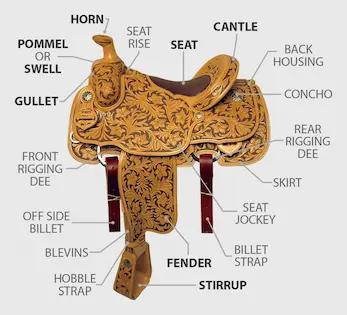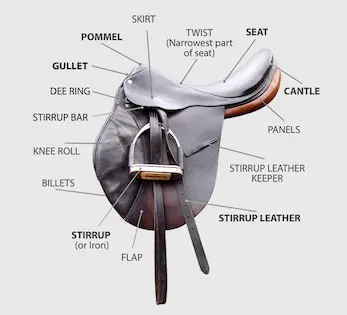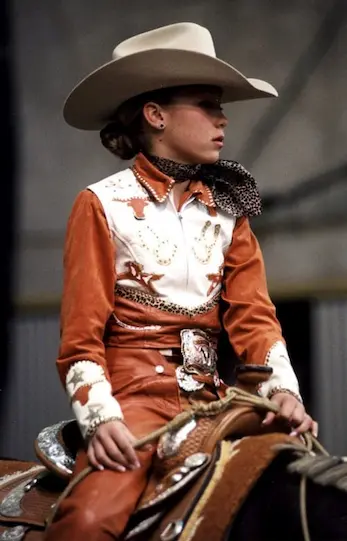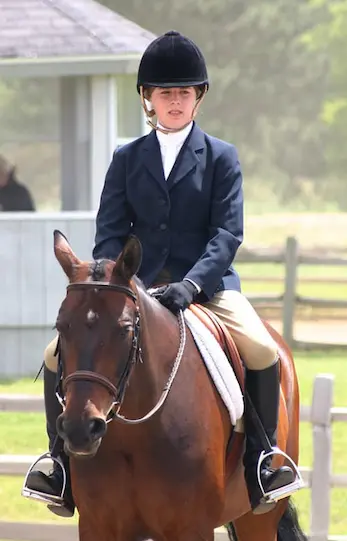When it comes to horse riding there’s a wide range of different equine sports, disciplines, and activities but as a rule, they will fall into one of two riding styles, Western or English, and while you can learn both most people will choose to stick to one or the other. Which style you opt for is down to personal preference but if you’re not sure what the differences are or which one might suit you best then this article will help. To some extent, though the style you opt for is, in part, determined by the country you live in, for example, Western is more popular in North America whereas English is more popular in most European countries. That doesn’t mean that you can’t learn to ride English if you live in North America or ride Western if you live in England.
What’s the difference between Western and English riding? At first glance, the most obvious difference between Western and English riding is the tack, and in particular the saddle, a Western saddle is much bigger and heavier than an English saddle.
Differences between Western and English Tack
At first glance, you might think that there are a lot of similarities between a Western and English saddle and while they may look alike they are very different. Yes, of course, they both have a seat, skirt, stirrups, a pommel, cantle, and a gullet but that’s where their resemblances end.
Western saddles are heavy saddles that were purposely developed to meet the needs of ranchers who not only spent long hours in the saddle but also needed a saddle they could securely rope a cow to. This has resulted in a saddle that distributes the weight more evenly along the horse’s back and also has a deeper seat to help the rider sit lower with their legs being more relaxed. While it will vary in size, depending on the style and purpose of the saddle, Western saddles also have a horn that can be used to anchor a rope to when working with cattle, or for the rider to hold onto when in fast turns.
English saddles, on the other hand, are far more traditional and lighter than Western saddles. The original English saddle, which is still used at the Spanish Riding School in Vienna, was actually not that dissimilar to the Western saddle but today’s English saddle can be traced back to the early 18th century. At this time fox hunting was extremely popular in England and Ireland which meant there was a need for a much lighter saddle that would be comfortable at speed, but more importantly over fences. Riders would often lean back as they went over fences which meant the saddle needed to have a much lower cantle. Since that time the saddle has evolved to give both the horse and the rider the best possible experience.
Bridles, on the other hand, are more or less the same although with Western a curb (or leverage) bit is more commonly used while a snaffle is the most common bit used with English riding.
When it comes to reins both Western and English styles use closed reins but a lot of Western riders choose to use split reins. As you can probably guess the difference between them is that the closed reins either consist of a single rein or two separate reins that are joined together, usually with a buckle. Split reins, on the other hand, are just that, they’re two separate reins that aren’t joined at all, they’re also a lot longer than closed reins. One advantage of split reins is that you don’t need to take them over the horse’s head but more importantly the horse can’t get tangled up in them.
Due to the safety factors concerning martingales in some competition arenas, as well as them not being allowed in most show rings, I decided to not really include them in this article, except to say that the tiedown is used almost solely in Western riding while the standing martingale, which is pretty similar, is used in English riding.
Differences between Western and English Clothing
Of course, if you’re riding for pleasure and aren’t interested in showing or competing at all then it doesn’t matter what you wear as long as it’s suitable for riding. If, however, you do want to compete then both styles have their own dress code which you need to follow.
Many shows, and disciplines for that matter, will have their own requirements but as a rule for Western riding, you’ll need to wear a western hat, although most shows/events will allow you to wear a riding helmet. You’ll also need to wear a shirt (you can wear it with either a scarf or a necklace for women or a bolo tie for men if you want), show pants or jeans with a Western belt and buckle (both the belt and buckle can be either plain or jeweled) and Western boots. You’re not allowed to wear spurs and could face immediate elimination if you do.
When it comes to English riding you must wear a riding helmet or hunt cap that meets the current regulations and is properly fastened. You also need to wear a fitted jacket, a white shirt (with either a tie or neck scarf and pin), jodhpurs or breeches, and tall riding boots.
Differences between Western and English Gaits
There is some difference in how Western and English horses are expected to move, for example, Western horses are expected to be smooth, travel low, and have consistency in their movements and speed. On the other hand, English horses generally have long flowing movements with a lot of variation in speed, depending on the discipline they’re also expected to be collected (This is where the horse not only has his hind legs further under his body but also has a more rounded back.).
Unless you’re riding a gaited horse (Gaited horses are horses that have been selectively bred for their natural way of going, as well as the usual walk, trot, and canter (and sometimes gallop) they also have at least one extra gait) both Western and English horses have the same gait, although some have different names.
Walk – A walk is a walk and there isn’t really any difference between a Western and an English walk.
Jog/Trot – Unlike a walk there are some differences between the two here. A jog, which is extremely relaxed and smooth, is a faster walk that is often used when herding cattle. In a jog, the rider stays seated in the saddle. The trot, however, is faster and bouncier than the jog and the rider can either sit or post/rise (Referred to as a posting or rising trot, this is where the rider rising out of the saddle with every other stride. It smoothes the trot out making it less bouncy).
Lope/Canter – While there can be a number of different canters such as elevated, extended, and collected there is only one type of lope which is slower than the canter.
Gallop – As with the walk there’s no difference between a Western and English gallop.
When it comes to riding styles English riding evolved for pleasure whereas Western riding originated on ranches where riders would spend all day in the saddle.
Differences between Western and English Horses
While there’ll be plenty of people that will rightly argue that any horse is capable of anything with the right training there are some horses that are better suited to certain things than other horses. After all, while a Thoroughbred is ideally suited to racing it’s probably not going to do so well pulling a plow on a farm. I’ve talked about breeds in a number of other articles so I won’t cover that here but will talk a little about the type of horse that’s popular with both styles.
As a very rough guide, Western horses tend to be stockier and more compact than English horses. They’re also able to work all day while still having the ability to spring into action should then need to chase stray cattle. Whereas English horses more often than not are taller and tend to be longer in the leg which helps them to cover vast distances as well as jump fences.
As I say though this is a very brief summary of a horse type, if you already have your own horse and are thinking about changing styles there’s no reason at all why you shouldn’t. You don’t need a particular horse for either style, especially if you’re just starting out.
Differences between Western and English disciplines
The main difference between English and Western disciplines is what they’re designed to display and demonstrate. Many English disciplines evolved as a way of displaying the rider’s ability as well as the horse’s versatility, while a lot of Western disciplines have their origins on the range and demonstrate a range of daily tasks
Western Disciplines
Within the Western style of riding, there are a number of different disciplines you may be interested in. Many of the competitive disciplines began life on the ranch and are variations on various tasks (such as rounding up cattle) or were designed to show a horse and riders ability, the most popular competition events are:
Roping – The idea behind roping is to rope a calf then dismount and tie his legs together as quickly as possible. As you can imagine, during the calving season, this is an everyday occurrence on a working ranch. You can also compete as a team which consists of two riders, one called the header who ropes the calf’s head while the other, called the heeler, ropes the calf’s heals. Whether you’re doing it individually or in a team the winner is the fastest to complete the task. You can find more information about roping on the United States Calf Ropers Association’s website.
Pleasure – At these events, the horse’s ability to perform certain gaits is judged, they should be able to perform the gaits in a quiet manner that makes the horse seem like it’s a pleasure to ride. The gaits, which must be performed in both directions, are walk, jog, and lope. The rider will also need to back the horse up quietly too.
Reining – Sometimes called high-speed dressage the idea is for the horse and rider to carry out a set routine that demonstrates the horse responsiveness as well as the control of the rider. Flying changes, spinning turns, rollbacks and sliding stops are some of the maneuvers. If you’re interested in knowing more about reining visit the National Reining Horse Association’s website.
Barrel Racing – With barrel racing you need to complete a cloverleaf pattern around a set of three barrels as quickly as you can. There are two types of races, the standard race where each competitor takes it in turn, and the Camas Prairie Stump Race where two riders compete at the same time on separate courses. With both events, the quickest rider is the winner. You can find out more about barrel racing on the International Barrel Racing Association’s website.
Team Penning – These events involve a team of riders removing a specific cow from a herd then moving it to a pen and keeping it there. It’s done against the clock with the quickest team winning. Team penning has recently seen a huge increase in popularity and you can find out more about the sport in this recent article I wrote: a beginner’s guide to getting started in team penning.
Cutting – Similar to team penning but instead of working in a team, an individual rider needs to separate (or cut) a cow from a herd and then prevent it from returning to the herd. The rider needs to anticipate what the cow will do and then outmaneuver the cow to stop it from returning to the herd. In cutting events the horse needs to be agile and extremely responsive to the rider’s commands. If you’re interested in learning more about cutting then check out the National Cutting Horse Association’s website.
English Disciplines
Like Western riding, there are some disciplines that are specific to English riding although, unlike Western, they’ve all evolved purely as recreational activities but do still test your skill as a rider as well as how well the horse is trained. The most popular disciplines are:
Jumping – As you can guess from the name jumping involves the horse and rider jumping a series of fences. The height of the fences will depend on the level you’re competing at but you’ll be penalized for every fence you either knockdown or your horse refuses to jump. Some events are against the clock while others raise the height of the fence for every round until there’s a winner. If you want to find out more about jumping there’s plenty of information on the Fédération Équestre Internationale’s website.
Dressage – Described as horse ballet, dressage is an extremely graceful and elegant discipline that really tests the training of the horse, the word dressage is actually derived from the French word for training. There are many different levels to dressage but to successfully complete any of them you’ll have to perform a series of maneuvers that become more complicated the higher the level. Like showjumping, it’s an international and Olympic sport and you can find out more about it on the official FEI website.
Eventing – Sometimes called three-day or one-day eventing it’s a blend of three different disciplines, dressage, cross-country (or hunting), and jumping that normally takes place over one or four days (despite the name three-day eventing is usually run over four days). It has its origins in the old cavalry tests that were designed to demonstrate a rider’s skill at a variety of disciplines. If you want to know more about eventing then check out the FEI’s website.
Hunting – Hunting began centuries ago when people would hunt a fox with dogs across the countryside but since then it’s changed and generally is either a cross country race (which is why it’s also called cross country) over natural fences or a drag hunt. A drag hunt mimics a fox hunt but instead of a fox, it involves a runner laying down a scent trail for dogs to follow.
Polo – A much older sport than you might think, the idea of polo can be traced back over two thousand years! Sometimes referred to as the sport of kings it’s a fast-paced game that involves teams of four riders competing to score as many goals as they can within an allotted time (usually 1 to 2 hours). The riders use long-handled wooden mallets to hit a small but hard ball into their opponent’s goal. You can learn more about polo on the Federation of International Polo’s website.
Saddle Seat – Especially popular in North America and South Africa it’s a classical style of riding that shows off the high knee actions of gaited horses. It originated from the ‘plantation’ style of riding where plantation owners wanted a comfortable way of riding around their estates. The horse and rider are both turned out to emphasize the flow of the sport with the rider wearing a long tailcoat and the horse often has a long flowing mane and tail.
Mixed Disciplines
While most disciplines fall into either Western or English riding there are a few that can be enjoyed by both styles. Disciplines such as endurance which is a race run over a set distance that can vary from around 10 miles (16km) to 100 miles (160km). They’re held over changeable terrain and test the horse and rider’s fitness and stamina, as well as the rider’s map reading skills. They’re organized events that have regular veterinary checks with horses being withdrawn immediately if the veterinarian deems the horse unfit. While it’s not an Olympic sport it is an International sport that is recognized by the FEI, you can find out more about the sport on their website. Mounted orienteering and Equicaching can also both be enjoyed with either riding style.
Is Western or English Riding Better For You?
When it comes to choosing whether to learn Western or English riding there’s no right or wrong, they both have their advantages and disadvantages and are largely down to personal preference. If you’re already interested in a particular discipline such as eventing then English is going to be better for you. If you don’t have any particular interest yet then there’s no reason why you couldn’t have a few lessons of both to give you an idea of which style may suit you best.
Further reading
- Unusual horse sports
- Barrel racing vs show jumping
- Best breeds for dressage
- Best breeds for trail riding
- Best breeds for eventing
- How to be a better rider
- How to buy and fit a saddle
- Finding the right bit for your horse
- Choosing the right helmet
- How to stay safe while riding at night
I hope you found this article helpful. If you did I’d be grateful if you could share it please as it would really help me.
Recommended products
Over the years I have tried hundreds of different horsey products, from various blankets and halters to different treats. Some I’ve loved, others I’ve hated but I thought I’d share with you my top all-time favorite products, the ones I never leave the yard without. I’ve included links to the products (which are in no particular order) that I really think are great.
- Horse Knots by Reference Ready – If you’re like me and enjoy pocket reference guides then you’ll love this knot tying guide. These handy cards can easily fit in your pocket or attach to the saddle for quick reference. They’re waterproof, durable and are color coded to make them easy to follow.
- Mane ’n Tail Detangler – Even if you never show your horse you’ll need to detangle his tail from time to time (and possibly his mane too) which is always a challenging chore! I’ve found that if I run a little bit of detangler through my horse’s tails every few days it stops them from getting matted up and makes combing them easy, even if they’re coated in mud. I don’t know if I should admit to this or not but it also works wonders on my hair.
- TAKEKIT Pro clippers – Over the years I’ve tried a lot of different clippers and while some were obviously better than others I found these to be by far the best. They are heavier than a lot of other clippers but for me, that’s a good thing, it makes them feel more sturdy and hardwearing. On top of that they have a range of speeds so are just as good for clipping your horse’s back as they are his face. I also like the fact that they come in a handy carry case but that’s not for everybody. The company that makes them is super good and incredibly helpful too, a real bonus these days. The only thing I wasn’t keen on was the fact that it doesn’t come with any oil, but that’s not a major problem as it’s not difficult to buy lubricant.
- Shire’s ball feeder – There are so many boredom buster toys out there but I like to use these every day, regardless of whether or not my horses are bored. I find that it helps to encourage my horses to problem solve by rewarding them with treats (or pieces of fruit) but it also mimics their natural grazing behavior which helps to keep them calm and de-stressed.
- Horse safe mirror – This is a strange one that many people are surprised about but I like to put horse safe mirrors in the trailers as well as in the quarantine stalls. It helps to prevent the feeling of isolation by giving the impression of other horses being around. Being herd animals horses can get extremely stressed when they feel that they’re on their own but with these stick-on mirrors, they believe that at least one other horse is with them.
- Rectal thermometer – I know this isn’t glamourous at all but it’s vital for your horse’s well-being to be able to check their temperature and a rectal thermometer is the easiest way of doing this which is why I’ve added it to the list.
Shopping lists
I’ve also put together a few shopping lists of essential items that I’ve found helpful over the years. I’ve broken the lists down into different categories rather than put everything in one massive list 😉





